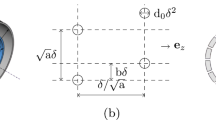Abstract
The concept of the perforation cell is specified for compact modelling of perforated gas dampers with micromechanical dimensions. Both, analytic expressions and FEM simulations, are used to derive its flow resistance. An extensive set of FEM simulations is performed to characterize the flow resistance of the cell, and to derive approximations for different flow regions by fitting simple functions to them. Sinusoidal small-amplitude velocities are assumed, and micromechanical dimensions are considered with rare gas effects in the slip flow regime (Knudsen number <0.1). The model is capable of modelling all practical combinations of the perforation cell dimensions in a wide range of perforation ratios (1,...,90%). Its validity is verified with a Navier–Stokes solver, and it is shown to be accurate (relative error <4.5%) in the continuum and slip flow regimes. Estimates for cut-off frequencies due to inertial and compressibility effects are specified in a way that the maximum operation frequency of the model can be easily tested. Using a harmonic FEM solver, these estimates are verified. The perforation cell model is also applied to estimate the damping in a perforated rectangular damper (4,...,64 square holes). The damping predicted by the simple model is in moderate agreement with that obtained with 3D FEM simulations.









Similar content being viewed by others
References
Bao M, Yang H, Sun Y, French PJ (2003a) Modified Reynolds equation and analytical analysis of squeezed-film air damping of perforated structures. J Micromech Microeng 13:795–800
Bao M, Yang H, Sun Y, Wang Y (2003b) Squeeze-film air damping of thick hole-plate. Sensors Actuators A 108:212–217
Dec A, Suyama K (1998) Micromachined electro-mechanically tunable capacitors and their application to RF ICs. IEEE Trans Microw Theor Tech 46(12):2587–2596
Ebert WA, Sparrow EM (1965) Slip flow in rectangular and annular ducts. J Basic Eng Trans ASME 87:1018–1024
Elmer (2005) Finite element solver for multiphysical problems. (n.d.) (http://www.csc.fi/elmer)
Goldsmith CL, Malczewski A, Yao ZJ, Chen S, Ehmke J, Hindel DH (1999) RF MEMs variable capacitors for tunable filters. Int J RF Microw CAE 9:362–374
Homentcovschi D, Miles RN (2004) Modeling of viscous damping of perforated planar microstructures, applications in acoustics. J Acoust Soc Am 116:2939–2947
Malinen M, Lyly M, Råback P, Kärkkäinen A, Kärkkäinen L (2004) A finite element method for the modeling of thermo-viscous effects in acoustics. In: Neittaanmäki P, Rossi T, Majava K, Pironneau O (eds) Proceedings of the 4th European congress on computational methods in applied sciences and engineering. Jyväskylä, Finland
Mattila T, Häkkinen P, Jaakkola O, Kiihamäki J, Kyynäräinen J, Oja A (2000) Air damping in resonant micromechanical capacitive sensors. In: 14th European conference on solid-state transducers, eurosensors xiv, Copenhagen, pp 221–224
Pedersen M, Olthuis W, Bergveld P (1997) A silicon condenser microphone with polyamide diaphragm and backplate. Sensors Actuators A 63:97–104
Råback P, Pursula A, Junttila V, Veijola T (2003) Hierarchical finite element simulation of perforated plates with arbitrary hole geometry. In: Proceedings of the 6th international conference on modeling and simulation of microsystems, vol 1, San Francisco, pp 194–197
Sattler R, Wachutka G (2004) Analytical compact models for squeezed-film damping. In: Symposium on design, test, integration and packaging of mems/moems, dtip 2004, Montreux, pp 377–382
Sharipov F, Seleznev V (1998) Data on internal rarefied gas flows. J Phys Chem Ref Data 27(3):657–706
Skvor Z (1967) On the acoustic resistance due to viscous losses in air gap of electrostatic transducers. Acoustica 19:295–299
Thurston GB (1952) Periodic fluid flow through circular tubes. J Acoust Soc Am 24:653–656
Veijola T (2001) Acoustic impedance elements modeling oscillating gas flow in micro channels. In: Proceedings of the 4th international conference on modeling and simulation of microsystems, Hilton Head, pp 96–99
Veijola T (2002) End effects of rare gas flow in short channels and in squeezed-film dampers. In: Proceedings of the 5th international conference on modeling and simulation of microsystems, San Juan, pp 104–107
Veijola T, Mattila T (2001) Compact squeezed-film damping model for perforated surface. In: Proceedings of transducers ’01, Munich, Germany, pp 1506–1509
Veijola T, Råback P (2005) A method for solving arbitrary mems perforation problems with rare gas effects. In: Proceedings of the 8th international conference on modeling and simulation of microsystems, Anaheim, vol 3, pp 561–564
Veijola T, Pursula A, Råback P (2005) Extending the validity of existing squeezed-film damper models with elongations of surface dimensions. J Micromech Microeng 15:1624–1636
Yang Y-J, Yu C-J (2002) Macromodel extraction of gas damping effects for perforated surfaces with arbitrary-shaped geometries. In: Proceedings of the 5th international conference on modeling and simulation of microsystems, San Juan, pp 178–181
Acknowledgements
The author wishes to thank Peter Råback for help with Elmer FEM simulations and Luis Costa who has contributed to this publication by reading and checking the English language used.
Author information
Authors and Affiliations
Corresponding author
Rights and permissions
About this article
Cite this article
Veijola, T. Analytic damping model for an MEM perforation cell. Microfluid Nanofluid 2, 249–260 (2006). https://doi.org/10.1007/s10404-005-0072-5
Received:
Accepted:
Published:
Issue Date:
DOI: https://doi.org/10.1007/s10404-005-0072-5




